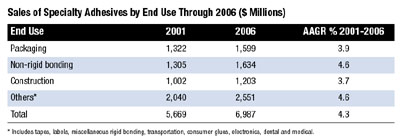
According to a new study from Business Communications Company, Inc., titled RC-176R Specialty Adhesives, the overall U.S. market for specialty adhesives was about $5.7 billion in 2001. This market is likely to reach nearly $7 billion as it grows at an average annual growth rate (AAGR) of 4.3% during the five-year forecast period.
The largest end use is packaging, which accounts for nearly 25% of the market. Currently estimated at $1.32 billion, this market is likely to use $1.6 billion of specialty adhesives by 2006. A close second is non-rigid bonding, with a $1.31 billion estimate in 2001. It is, however, growing at a faster AAGR of 4.6% and is expected to cross $1.6 billion by 2006. Dental and medical applications will show the most growth at 5.9% a year. Other fast-growing uses will be tapes and labels, electronics, and non-rigid bonding.
The major type of adhesive used is hot melt adhesives, which have almost one-quarter of the dollars. Also important are pressure sensitive adhesives, and adhesives based on polyvinyl acetate, polyurethanes and acrylics.
Adhesives are bonded by several different methods, including:
Convenience of application is important in the evaluation of adhesives. Rapid dispensation of controlled quantities, often under high-speed manufacturing conditions, is necessary, and adhesives must spread rapidly to a uniform thickness with good surface-wetting properties, preferably without any fire or toxicity hazard. The latter requirement obviously favors the use of aqueous dispersions.
For more information on RC-176R Specialty Adhesives (published June 2002), contact Business Communications Co., Inc., 25 Van Zant Street, Norwalk, CT 06855; phone 203-853-4266; ext. 309; e-mail publisher@bccresearch.com; or visit www.bccresearch.com. Or Circle No. 52.